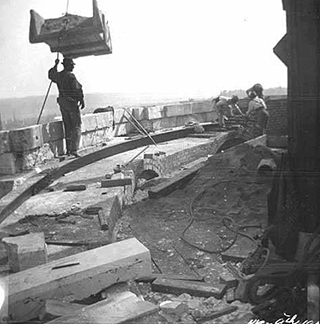
[image_credit]Courtesy of the Minnesota Historical Society[/image_credit][image_caption]Men working in the area of the Capitol dome, ca. 1901. Note the lack of hardhats as the workers hoist heavy materials above their heads.[/image_caption]
Six workers were killed in accidents during the building of the Minnesota State Capitol between 1898 and 1903. The deaths resulted from unsafe working conditions that labor laws have greatly improved since that time. After being nearly forgotten, the six builders were honored in 2011, 2012, and 2017 by ceremonies and a plaque at the Capitol.
The Minnesota State Capitol came at a cost; six workers died building it. These builders were forgotten for more than 100 years after their deaths.
The first worker to lose his life on the construction project was Felix Arthur, who came north with the marble shipped to St. Paul from a quarry in Georgia. He was working on a stone-polishing machine when he got caught in the flywheel. He died in the hospital several hours later, on May 5, 1898, at the age of twenty-five.
Arthur’s family was prominent, so the Georgia Marble Company paid for his elaborate grave marker in Nelson, Georgia. The families of later Capitol accident victims did not receive such support.
All other statehouse deaths were caused by falls. John Biersack, the thirty-six-year-old son of Bavarian immigrants to Wisconsin, died in October 1898, a few days after he fell from a hoist. Like all of the other fatal accident victims, Biersack was unmarried and had no children.
A freak accident killed twenty-year-old Albert Swanson, a mold caster from Sweden. The St. Paul Globe’s headline for the story summarized the incident: “Passing Wagon Drives over Rope used to Hoist Materials and Scaffolding, on Which Men Stood, Falls.” Swanson and Frank Thiery fell forty feet; Swanson collided with scaffolding and died before hitting the ground. Thiery landed on a pile of sand and broke his leg but was able to go home from the hospital that night.
Another Swedish immigrant, twenty-year-old stonemason Alfred Magnuson, was the nephew of Capitol master stonemason Nils Nelson. Magnuson fell thirty feet on June 25, 1900. He died in St. Joseph’s Hospital four days later.
Florian Zauner was born in Germany forty years before he worked as a laborer on the Capitol, where he fell seventy feet and died immediately on August 3, 1900. Few details about the lives of Zauner and Magnuson survive. Even their exact burial locations are unknown.
On June 25, 1903, eighteen-year-old John Corrigan fell thirty-two feet to his death in the unfinished House Chamber. After less than two weeks on the job, Corrigan had lost his balance while carrying a heavily-loaded wheelbarrow across a narrow and unguarded gangway.
These accidents stirred controversy about unsafe conditions at the Capitol site. An 1899 St. Paul Globe headline read, “Railing Is Needed There—Safety Device Suggested By The Labor Bureau For Capitol Workers.”
By June 27, 1903, the outrage in the Minneapolis Journal headline was clear: “Deaths Due To Neglect.” The article noted that contractors had been ordered to widen high runways, but they were still too narrow “to protect a man from momentary dizziness.” The outcry over young Corrigan’s death may finally have changed worksite conditions. He was the last worker to die during construction of the Capitol, which opened to the public in 1905.
![]() While inspectors visited worksites and issued safety orders, they did not have the power to make employers pay fines or face legal consequences. Attitudes about worksite hazards were also different then. HGA architect Ginny Lackovic, who supervised the 2010 Capitol dome repairs, said, “I think the level of safety when this building was built was based on everybody’s sense of their own judgment. Your safety was your own responsibility and if you made a mistake you paid dearly for it.”
While inspectors visited worksites and issued safety orders, they did not have the power to make employers pay fines or face legal consequences. Attitudes about worksite hazards were also different then. HGA architect Ginny Lackovic, who supervised the 2010 Capitol dome repairs, said, “I think the level of safety when this building was built was based on everybody’s sense of their own judgment. Your safety was your own responsibility and if you made a mistake you paid dearly for it.”
Because worker’s compensation laws weren’t enacted in Minnesota until 1913, receiving compensation for workplace accidents required proving negligence by the employer and proper behavior by the employee—a difficult, expensive, and time-consuming process. Mutual benefit societies and unions provided some illness, accident, and death assistance.
Safety laws and technical innovations have greatly improved workplace safety in the 2000s. Insurance programs help those who are injured or killed.
The six builders were finally recognized publicly during Workers Memorial Day ceremonies in 2011 and 2012. They were honored by a plaque installed in the Capitol in 2017, thanks to a group of Owatonna middle school students who, after studying the Labor Education Service’s Capitol project website, successfully lobbied for a bill authorizing the memorial.
For more information on this topic, check out the original entry on MNopedia.






